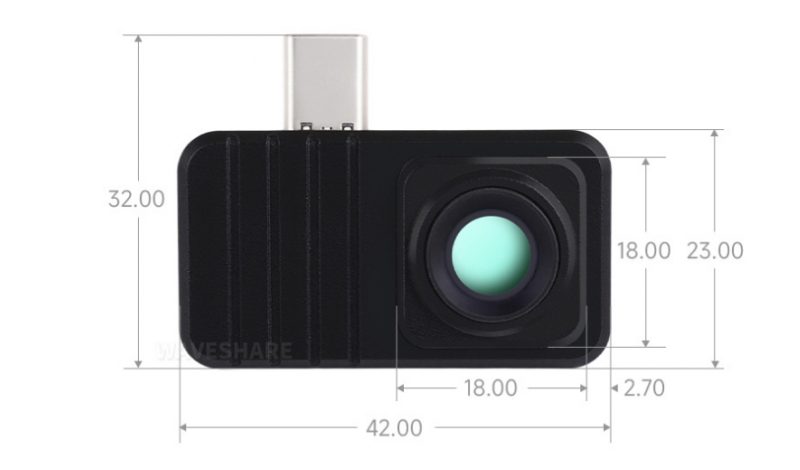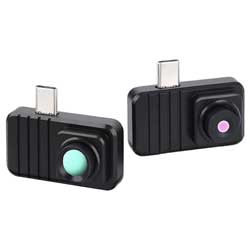- sales/support
Google Chat: zj734465502@gmail.com
- sales
+86-0755-88291180
- sales01
sales@spotpear.com
- sales02
dragon_manager@163.com
- support
tech-support@spotpear.com
- CEO-Complaints
zhoujie@spotpear.com
- sales/support
WhatsApp:13246739196
- HOME
- >
- ARTICLES
- >
- Common Moudle
- >
- Camera
Thermal-45-USB-Camera-C User Guide
Introduction
This product is a mobile phone thermal imager with an aluminum alloy case. It adopts the hybrid technology of microbolometer and thermopile pixel with 160×120 pixel focus array, which can detect the infrared radiation energy distribution of the object in the field of view of the lens, and then obtain the surface temperature distribution of the object after quantitative processing and generate the thermal imaging map. It has a Type-C interface, which can be directly connected to mobile phone devices, plug and play. This product is available in 45° and 88° field of view versions for users to choose.
Features
- Hybrid technology of microbolometer and thermopile with 160(H)×120(V) pixels
- Continuous operation and thermal imaging video stream due to shutterless design
- Up to 9FPS (Max) thermal imaging video stream output
- Comprehensive supporting manuals (Android host device and user manuals etc.)
Specifications
- Operating voltage: 5V
- Operating voltage: 81mA@5V
- Wavelength range: 8~14μm
- Field of View (FOV):
- 56°(D) × 45°(H) × 34°(V) (Baisc version)
- 110°(D) × 88°(H) × 66°(V) (Wide angle version)
- Operating temperature: -20°C~85°C
- Target Temperature:
- 20℃~300℃ (Basic version)
- 20℃~250℃ (Wide angle version)
- Detection accuracy: ±3.5℃
- Refresh Rate: 9 FPS(Max)
- Dimensions: 42 x 23 (mm)
Hardware Description
- Thermal USB Camera (C) connects to Android phone and uses the USB interface to send temperature data
- If the Thermal USB Camera (C) is abnormal, it can be replugged and re-plugged for hardware reset
Hardware Connection
- Thermal USB Camera (C) is connected to an Android phone
Dimensions

Temperature Measurement Principle
What is infrared temperature measurement? (Refer to OPTRIS)
In the field of measurement, "temperature" is one of the most commonly used physical parameters after "time". Based on the principles of Planck's and Boltzmann's radiation laws, an infrared thermometer measures the temperature of an object by absorbing the infrared radiation emitted by the object. So, how does non-contact temperature measurement work?
Any object with a temperature above absolute zero (0 K or -273.15 °C) emits electromagnetic radiation from the surface, and the radiation is proportional to the object's inherent temperature. This radiation includes infrared radiation used to achieve temperature measurement. When this radiation penetrates the atmosphere, it can be concentrated on the detector with the help of a special lens. The detector then generates an electrical signal proportional to this radiation. This signal is amplified and converted into an output signal proportional to the temperature of the object by undergoing continuous digital signal processing. In this way, the measured value of the temperature will be displayed on the display, or output as a signal.
In the application of radiation for temperature measurement, the emissivity ε (Epsilon) plays a crucial role. It shows the relationship between the radiation values of actual objects and those of a black body. The emissivity of a black body is 1 (maximum value). However, there are not many objects that can meet the ideal condition of a black body. When calibrating the sensor, the contact surface of the radiator (including the recommended wavelength: 0.99) is generally used.
In terms of their wavelength, many objects usually have a constant emissivity, but their radiation capacity is much inferior to that of a black body, they are called gray bodies. If the emissivity of an object depends on its temperature and wavelength (e.g., metal), it is called a selective radiator. In both cases, the missing radiation part is explicitly supplemented by the radiation rate. When using selective radiators, it is important to keep in mind the wavelength being measured (for metals, short wavelengths are chosen).
In addition to the radiation emitted from the surface of the object, the infrared sensor can also receive reflected radiation from the surrounding environment and perhaps penetrating infrared radiation from the object being measured.
Measurement Accuracy
When the target object exceeds the FOV of the module by 25% or more, the relative humidity should be below 95%, and there should be no condensation vapor or moisture on the lens
- Basic version:
| Operating temperature °C | Target temperature °C | Maximum deviation °C | |
| Full-frame accuracy | 30.0 | 0.0-100.0 | ±3.5℃ |
| 30.0 | >100.0 | the bigger of ±5.0 or 5% | |
| 30.0 | <0.0 | TBD | |
| Single pixel | 30.0 | 0.0-100.0 | ±1.0℃ |
- Wide angle version:
| Operating temperature °C | Target temperature °C | Maximum deviation °C | |
| Full-frame accuracy | 30.0 | 0.0-100.0 | ±3.5℃ |
| 30.0 | <0.0 | the bigger of ±5.0 or 5% | |
| 30.0 | >100.0 | TBD | |
| Single pixel | 30.0 | 0.0 to +100.0 | ±1.0℃ |
Main Applications
- Long-term non-contact object temperature online monitoring solution
- IR thermal imaging devices, IR thermometers
- Smart home, intelligent building, intelligent lighting
- Industrial temperature control, security & safety, intrude/motion detection
- Small target thermal analysis, heat trend analysis and solutions
Usage Guide
Android
- Plug the module directly into the Android phone
- Install APP on your Android phone and open it, the APP will automatically recognize and turn on the infrared thermal imaging camera, if it does not turn on automatically, please plug and unplug the Type-C cable again
- When the Thermal USB Camera is connected, the thermal image is displayed in the APP software, and the corresponding temperature value can be displayed by clicking on the object in the field of view corresponding to the display in the thermal image
- In the APP software, the triangular arrow located at the lower left of the thermal image allows you to select different rendering modes for thermal images. The default mode is HEATED_IRON. The up and down arrows in the FPS (Frames Per Second) section on the right can be used to adjust the frame rate or to utilize dynamic frame rate
- SNAPSHOT and RECORD are for capturing thermal image screenshots and recording videos, AI FILTER is for filtering image noise, and FEVER DETECTION can estimate the distance between the person and the camera lens and detect body heat after facial recognition
Resources
Softwares
Datasheets
- MI1602 Datasheet
Support
Monday-Friday (9:30-6:30) Saturday (9:30-5:30)
Email: services01@spotpear.com




